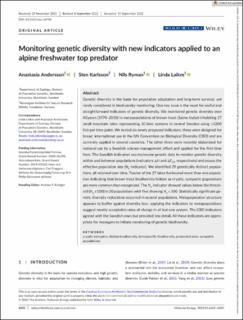| dc.contributor.author | Andersson, Anastasia | |
| dc.contributor.author | Karlsson, Sten | |
| dc.contributor.author | Ryman, Nils | |
| dc.contributor.author | Laikre, Linda | |
| dc.date.accessioned | 2023-02-27T14:49:43Z | |
| dc.date.available | 2023-02-27T14:49:43Z | |
| dc.date.created | 2022-11-15T13:48:38Z | |
| dc.date.issued | 2022 | |
| dc.identifier.citation | Molecular Ecology. 2022, . | en_US |
| dc.identifier.issn | 0962-1083 | |
| dc.identifier.uri | https://hdl.handle.net/11250/3054373 | |
| dc.description.abstract | Genetic diversity is the basis for population adaptation and long-term survival, yet rarely considered in biodiversity monitoring. One key issue is the need for useful and straightforward indicators of genetic diversity. We monitored genetic diversity over 40 years (1970–2010) in metapopulations of brown trout (Salmo trutta) inhabiting 27 small mountain lakes representing 10 lake systems in central Sweden using >1200 fish per time point. We tested six newly proposed indicators; three were designed for broad, international use in the UN Convention on Biological Diversity (CBD) and are currently applied in several countries. The other three were recently elaborated for national use by a Swedish science- management effort and applied for the first time here. The Swedish indicators use molecular genetic data to monitor genetic diversity within and between populations (indicators ΔH and ΔFST, respectively) and assess the effective population size (Ne- indicator). We identified 29 genetically distinct popula-tions, all retained over time. Twelve of the 27 lakes harboured more than one popula-tion indicating that brown trout biodiversity hidden as cryptic, sympatric populations are more common than recognized. The Ne indicator showed values below the thresh-old (Ne ≤ 500) in 20 populations with five showing Ne< 100. Statistically significant ge-netic diversity reductions occurred in several populations. Metapopulation structure appears to buffer against diversity loss; applying the indicators to metapopulations suggest mostly acceptable rates of change in all but one system. The CBD indicators agreed with the Swedish ones but provided less detail. All these indicators are appro-priate for managers to initiate monitoring of genetic biodiversity | en_US |
| dc.language.iso | eng | en_US |
| dc.rights | Attribution-NonCommercial-NoDerivatives 4.0 Internasjonal | * |
| dc.rights.uri | http://creativecommons.org/licenses/by-nc-nd/4.0/deed.no | * |
| dc.subject | cryptic sympatry | en_US |
| dc.subject | hidden biodiversity | en_US |
| dc.subject | intraspecific biodiversity | en_US |
| dc.subject | protected area | en_US |
| dc.subject | sympatric populations | en_US |
| dc.title | Monitoring genetic diversity with new indicators applied to an alpine freshwater top predator | en_US |
| dc.title.alternative | Monitoring genetic diversity with new indicators applied to an alpine freshwater top predator | en_US |
| dc.type | Peer reviewed | en_US |
| dc.type | Journal article | en_US |
| dc.description.version | publishedVersion | en_US |
| dc.rights.holder | © 2022 The Authors | en_US |
| dc.subject.nsi | VDP::Zoologiske og botaniske fag: 480 | en_US |
| dc.subject.nsi | VDP::Zoology and botany: 480 | en_US |
| dc.source.pagenumber | 18 | en_US |
| dc.source.journal | Molecular Ecology | en_US |
| dc.identifier.doi | 10.1111/mec.16710 | |
| dc.identifier.cristin | 2074287 | |
| dc.relation.project | Andre: Carl Trygger Foundation | en_US |
| dc.relation.project | Andre: Swedish Research Council Formas | en_US |
| dc.relation.project | Andre: Swedish Research Council | en_US |
| dc.relation.project | Andre: Erik Philip-Sörensen Foundation | en_US |
| dc.relation.project | Andre: Swedish Agency for Marine and Water Management | en_US |
| cristin.ispublished | true | |
| cristin.fulltext | original | |
| cristin.qualitycode | 2 | |

